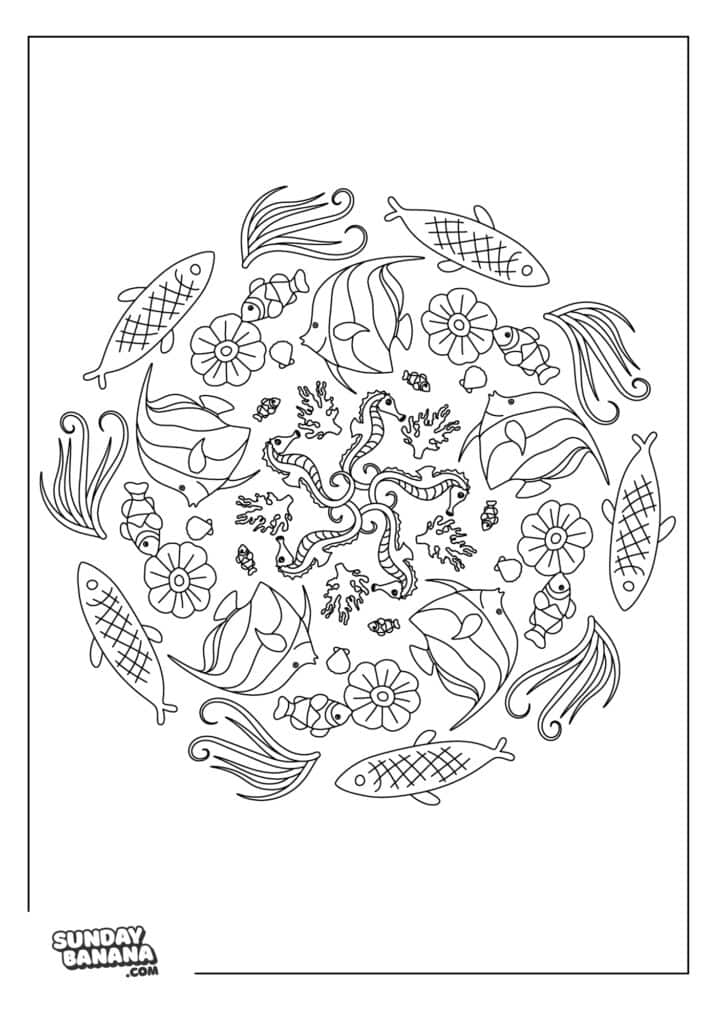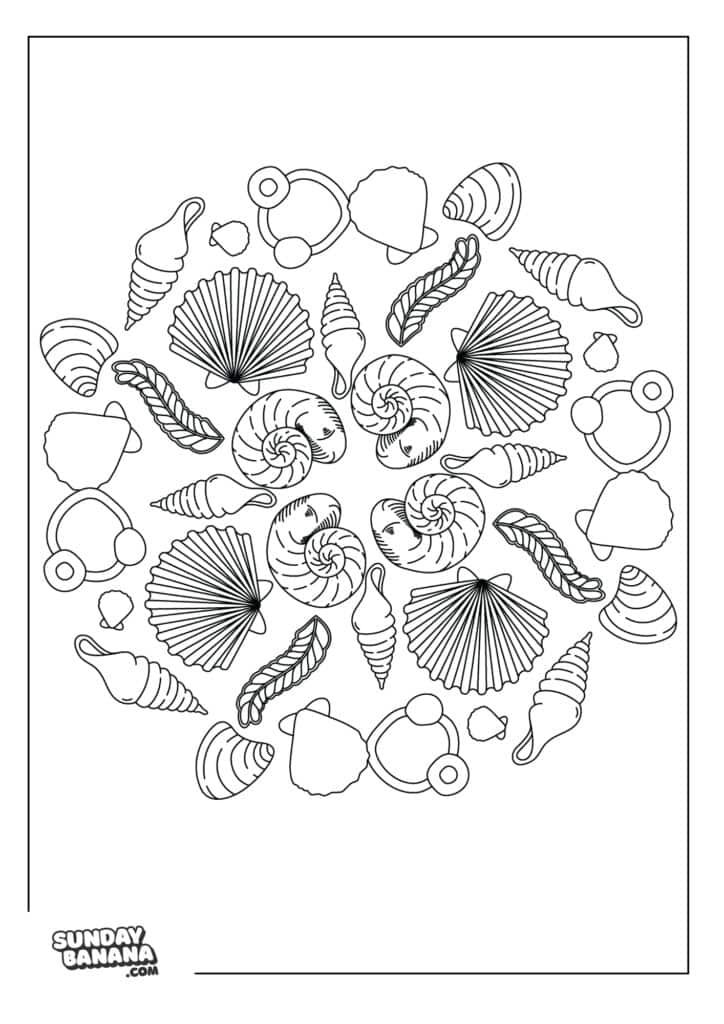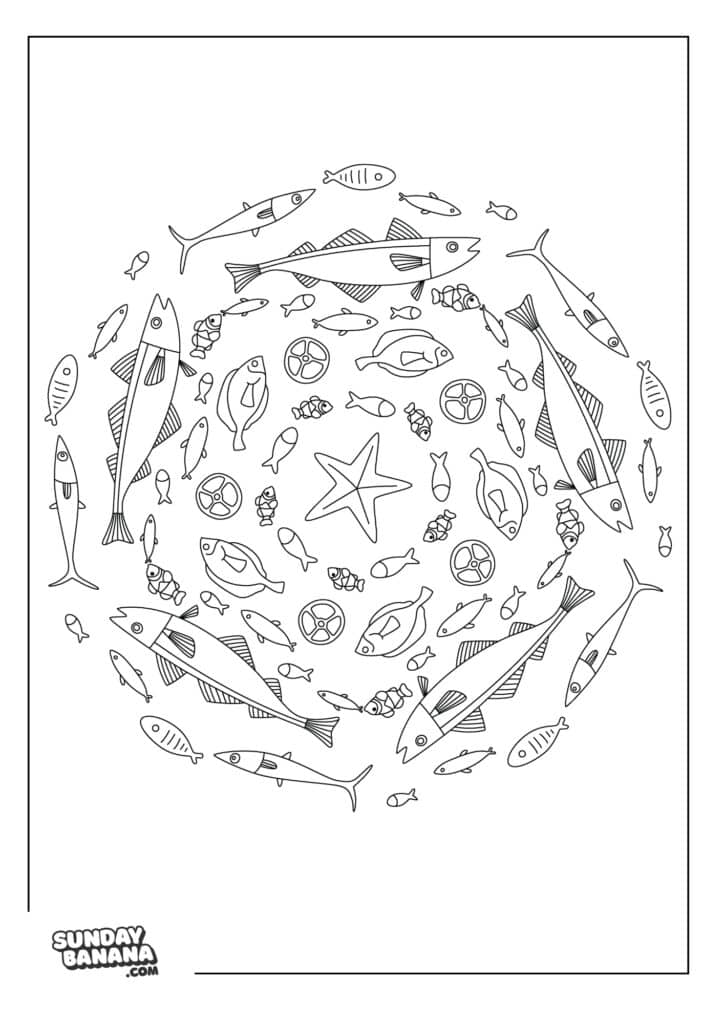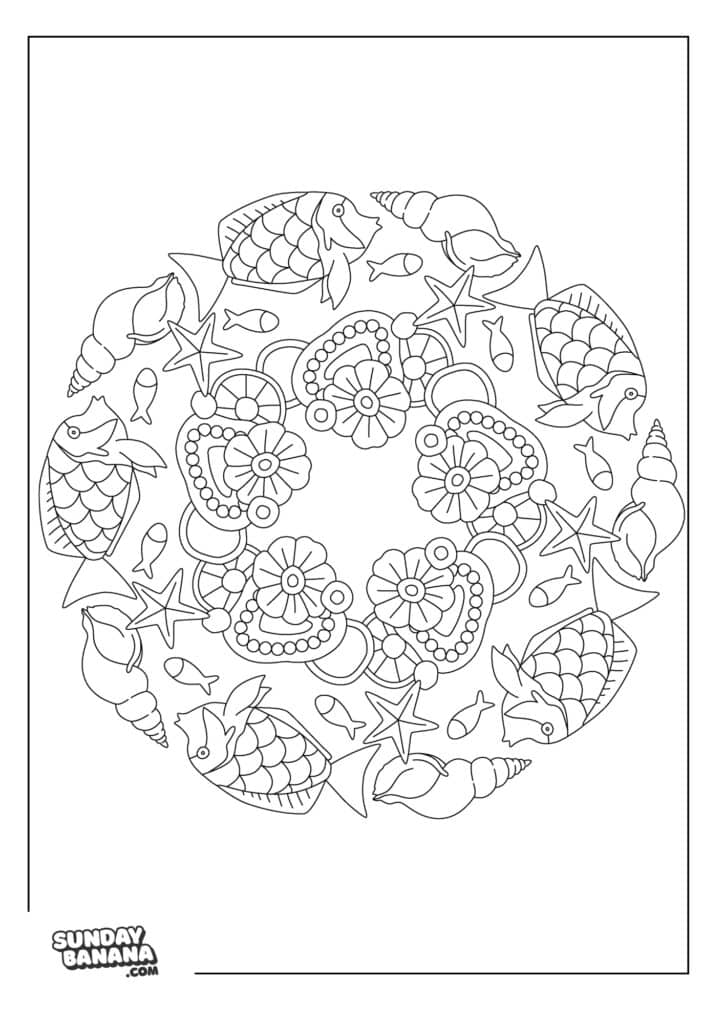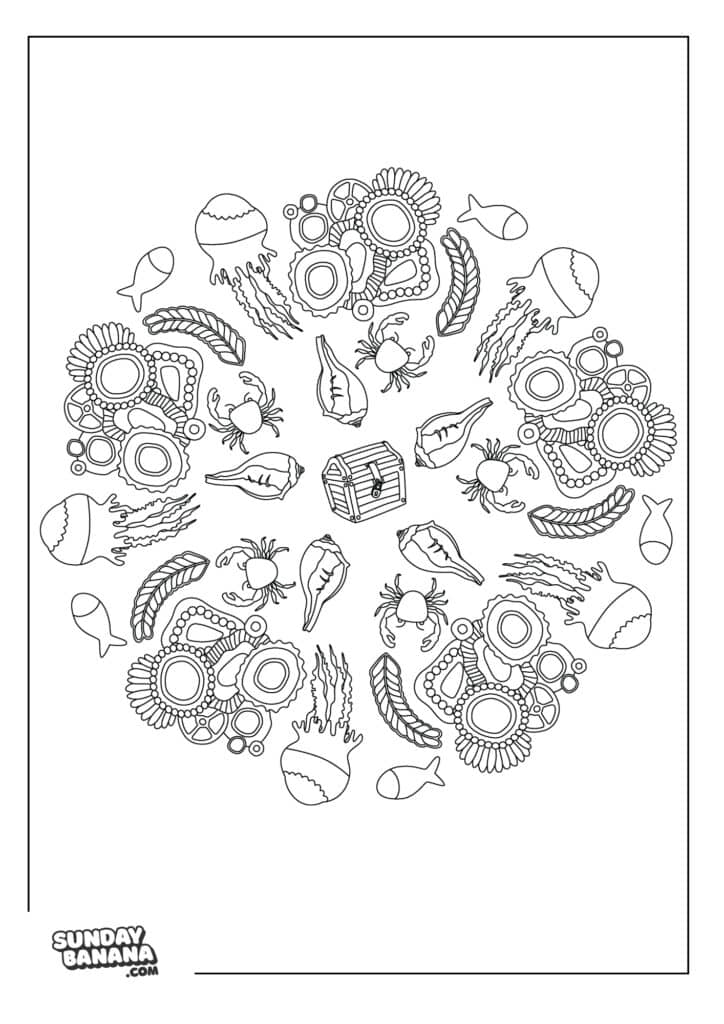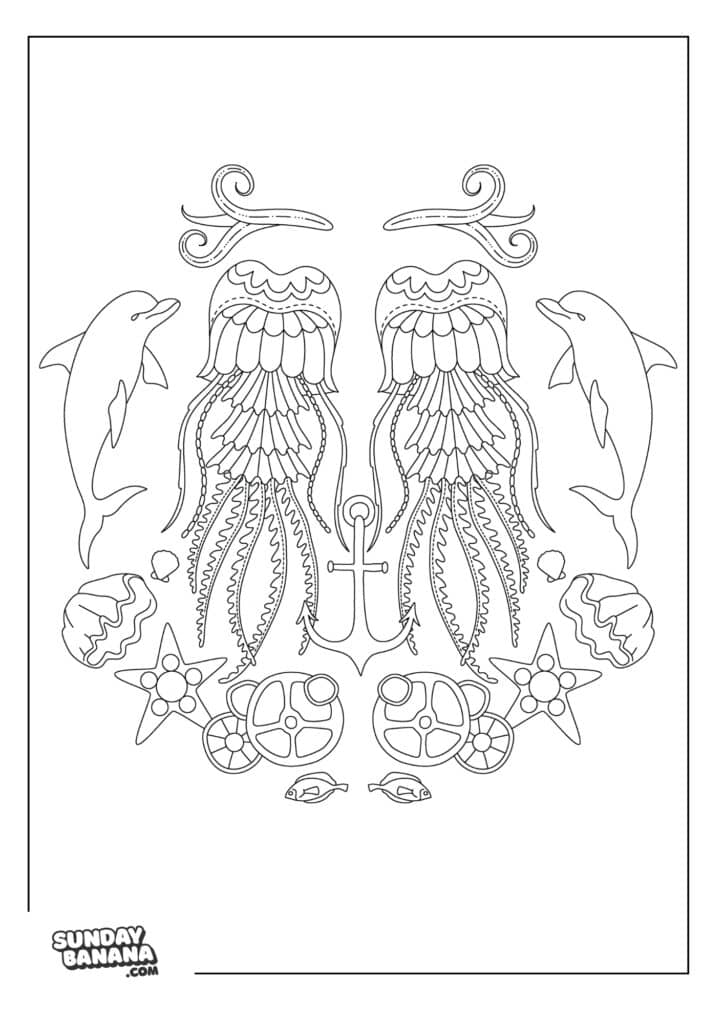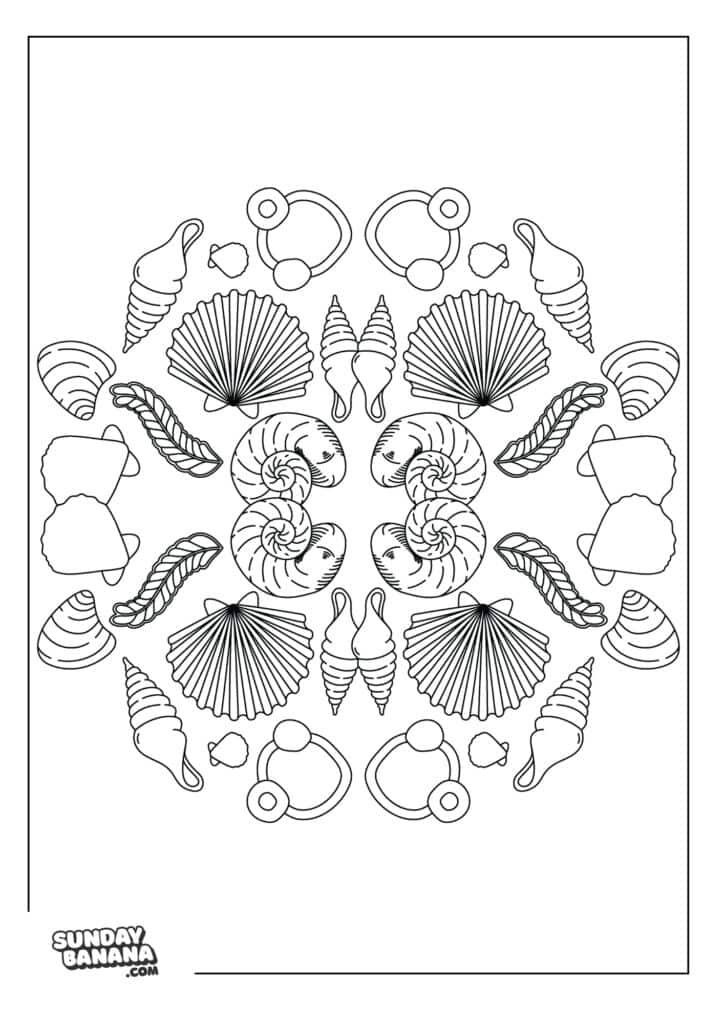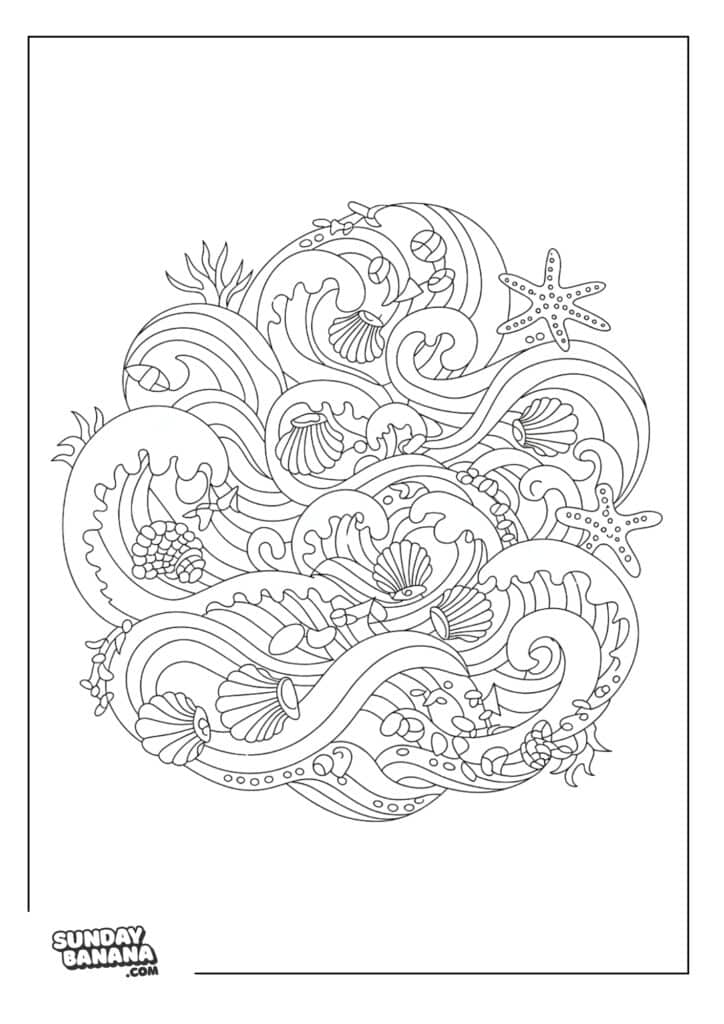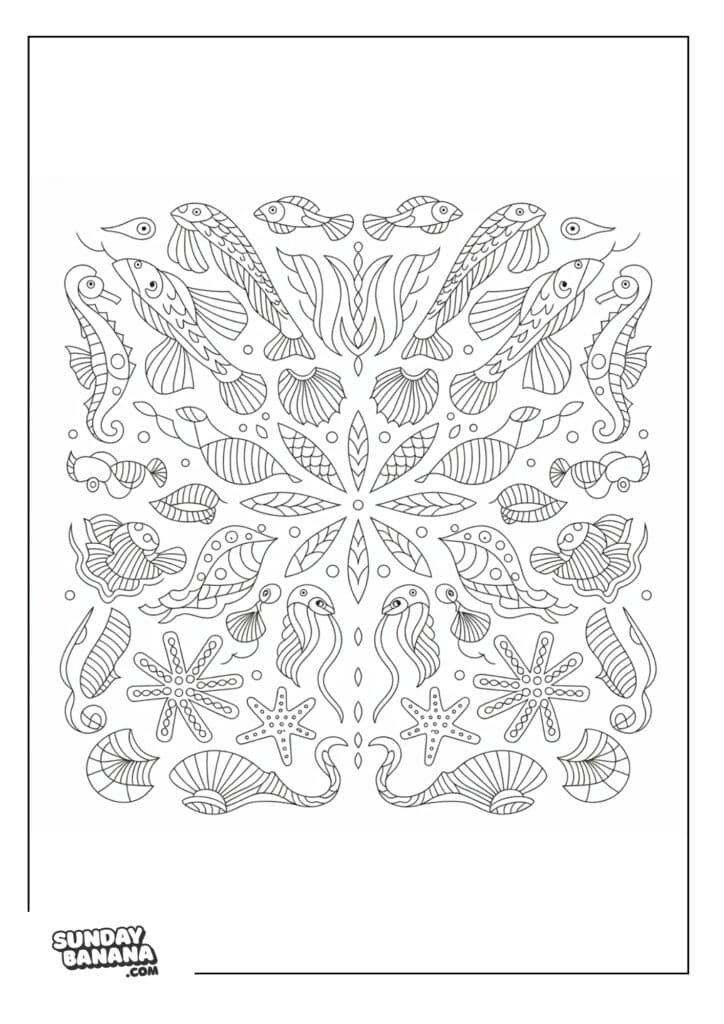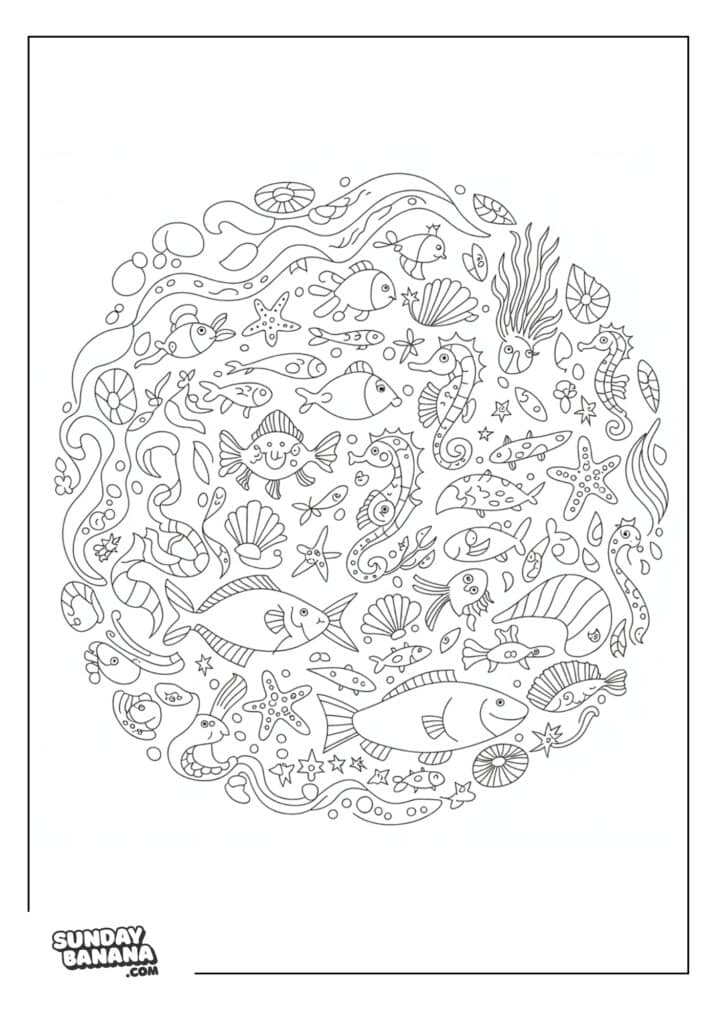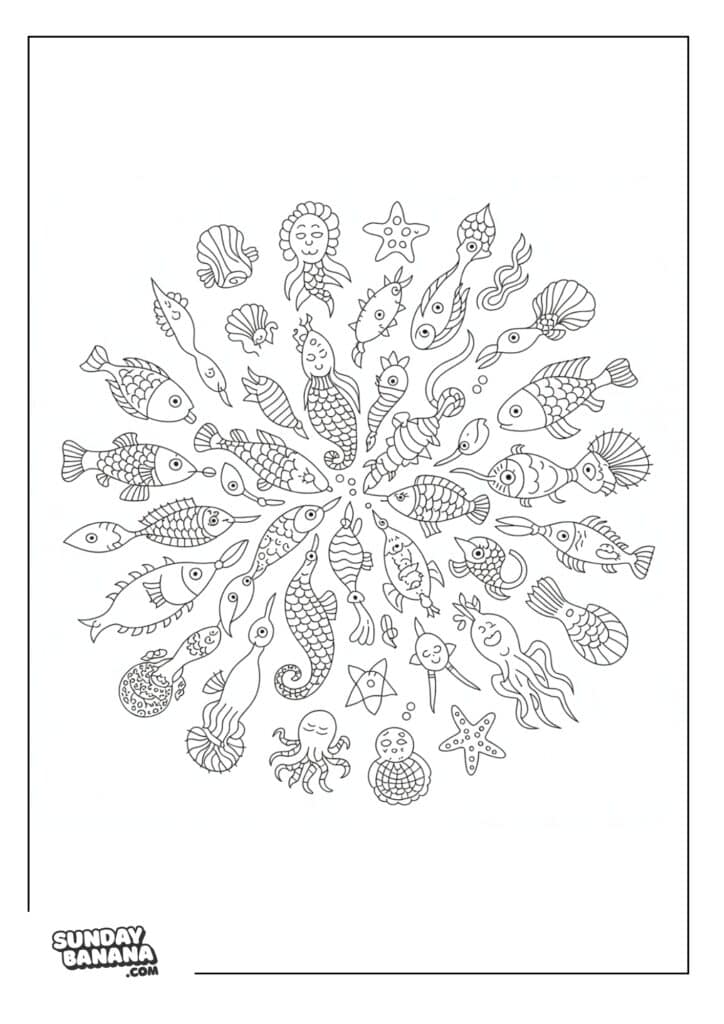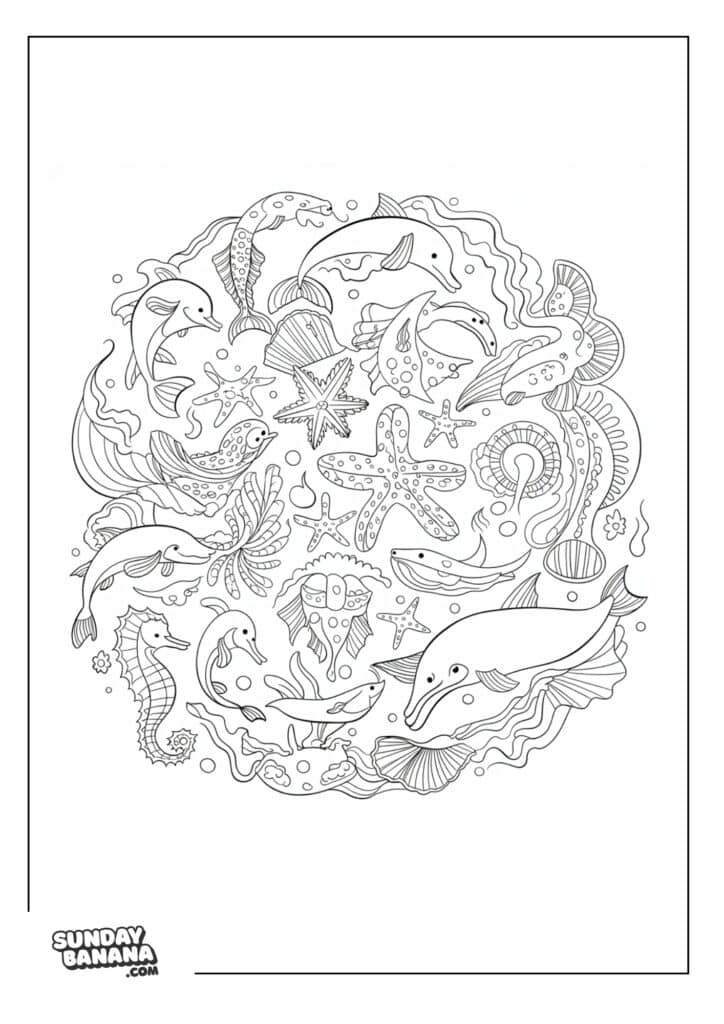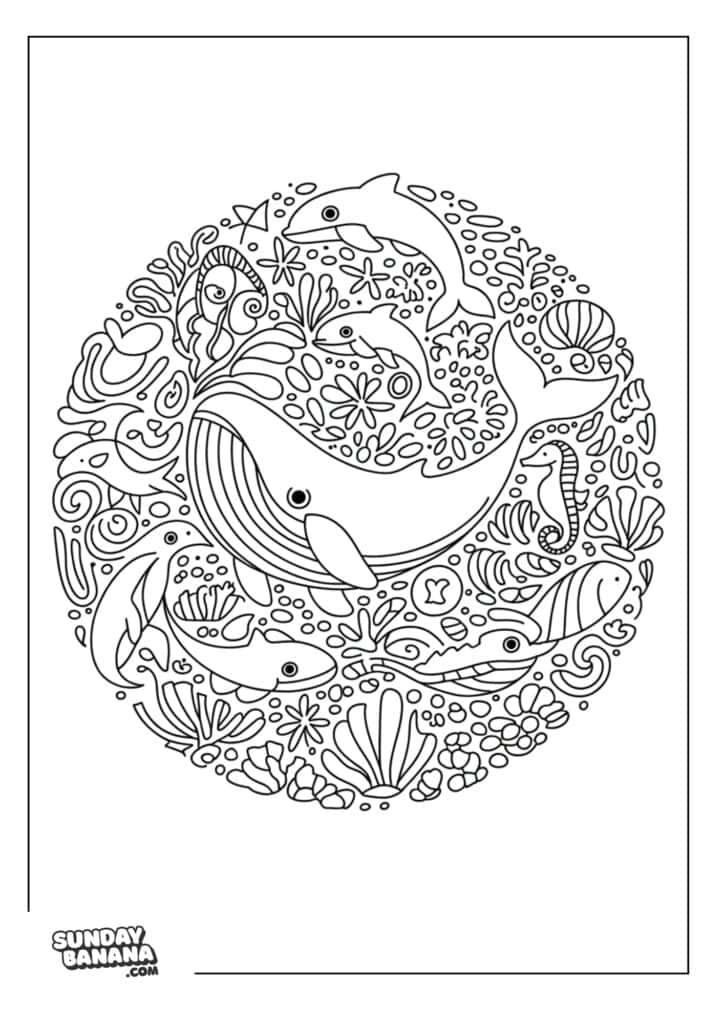Ocean Life Mandala coloring pages have become my go-to solution for basically everything. Bad day at work? Color a mandala whale. Can’t sleep? Grab some colored pencils and dive into a geometric octopus. I’m telling you, these free Ocean Life Mandala coloring sheets are like therapy, but way more fun and with zero awkward small talk! There’s something magical about watching a simple seahorse transform into this intricate work of art while your brain finally gets to take a break from adulting.
Can we talk about how satisfying it is to color inside those tiny mandala details? Our Ocean Life Mandala printable coloring pages are designed for those moments when you need to disappear into your own little world for a while. From starfish surrounded by swirling patterns to whales decorated with sacred geometry, these free coloring pages let you explore the depths of your creativity without getting sand in uncomfortable places. Plus, I’ve discovered that coloring these underwater mandala designs is the perfect excuse to ignore text messages. “Sorry, I was communing with a spiritual dolphin” is totally valid, right?
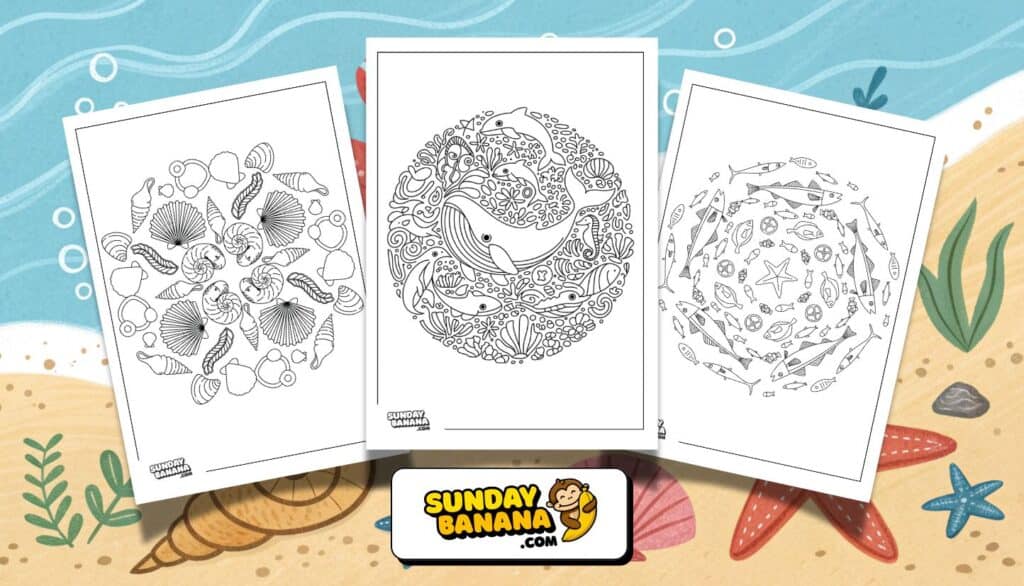
To start coloring, click on any of the below images or links to open the free PDF. Once opened, you can then download or print as many pages as you like.
All of the below pages are on A4 sized paper, but they also scale perfectly onto US-letter paper too! Happy coloring!
More Ocean Life Mandala Coloring Pages Coming Soon!
More Free Printable Coloring Pages
Want more super cool coloring stuff that kids go crazy for? Check out our awesome coloring page collections! They’re totally fun and packed with pictures just waiting for your crayons and markers to make them pop!
12 Fun Crafts To Do Together With Ocean Life Mandala Coloring Pages
1. Paper Plate Jellyfish Ocean Craft
Transform ordinary paper plates into flowing jellyfish using colorful streamers and household materials perfect for ocean life crafts for kids!
Materials:
- Paper plates (white or colored)
- Crepe paper streamers or plastic bags
- Watercolor paints or food coloring
- Cotton balls for texture
- Hole punch
- Yarn or string
- Glue sticks
- Scissors
- Iridescent glitter (optional)
Age Range: 4-13 years
Instructions:
- Paint your paper plate jellyfish body using watercolor paints in ocean colors like pink, purple, or blue for realistic ocean animal crafts.
- While paint dries, cut crepe paper streamers into various lengths (6-12 inches) to create flowing jellyfish tentacles.
- Glue cotton balls around the plate edges to add dimensional texture to your ocean life craft project.
- Punch 6-8 holes evenly around the bottom rim of your jellyfish paper plate for tentacle attachment.
- Thread colorful streamers through holes and secure with knots to create graceful flowing tentacles.
- Add iridescent glitter for magical underwater effects and hang your jellyfish ocean craft from ceiling for display.
2. Egg Carton Sea Creatures Ocean Diorama
Create an entire underwater ecosystem using recycled egg cartons and transform them into various ocean animals for educational marine life crafts.
Materials:
- Cardboard egg cartons
- Acrylic paints or tempera paints
- Pipe cleaners for details
- Googly eyes in various sizes
- Craft foam sheets
- Shoe box for diorama base
- Blue cellophane or tissue paper
- Hot glue gun (adult supervision)
- Scissors and paintbrushes
Age Range: 6-13 years
Instructions:
- Cut individual egg carton cups to create octopus bodies, crab shells, and sea anemone bases for your ocean life crafts collection.
- Paint each sea creature in vibrant ocean colors – orange for crabs, purple for octopi, green for sea anemones.
- Add pipe cleaner legs and arms to create realistic ocean animal movements and characteristics.
- Glue googly eyes onto each creature and add foam details like fins, claws, or tentacle suckers.
- Line shoe box with blue cellophane to simulate ocean water environment for your marine life diorama.
- Arrange your egg carton ocean creatures inside the diorama and add sand or pebbles for authentic ocean floor effects.
3. Coffee Filter Ocean Fish Art Project
Design beautiful translucent fish using coffee filters and food coloring to create stunning ocean life wall art for kids.
Materials:
- Round coffee filters
- Liquid food coloring set
- Spray bottles with water
- Clothespins for drying
- Construction paper (blue/green)
- Scissors and glue sticks
- Black markers for details
- Aluminum foil (optional)
- String for hanging display
Age Range: 5-13 years
Instructions:
- Fold coffee filters into triangular fish shapes and secure with clothespins for your ocean animal art project.
- Mix food coloring with water in spray bottles creating vibrant ocean colors like turquoise, coral, and yellow.
- Spray colored water onto folded coffee filters and watch colors blend naturally for realistic fish patterns.
- Unfold dried filters to reveal beautiful tie-dye fish designs perfect for ocean life crafts display.
- Cut construction paper into ocean wave shapes and glue dried fish filters onto blue background.
- Add details with black markers like fish eyes, scales, and fins to complete your ocean life art masterpiece.
4. Toilet Paper Roll Whale Ocean Craft
Transform toilet paper rolls into majestic whales and dolphins using paint and creative household materials for marine animal crafts.
Materials:
- Toilet paper rolls or paper towel tubes
- Blue and gray acrylic paints
- White construction paper
- Cotton swabs for painting details
- Plastic bottle caps for blowholes
- Scissors and craft knife (adult use)
- Black markers
- Aluminum foil for water spouts
- Double-sided tape
Age Range: 6-13 years
Instructions:
- Paint toilet paper rolls in whale colors like gray, blue, or black for authentic ocean animal appearance.
- Cut paper tubes slightly to create whale tail shapes and realistic marine mammal proportions.
- Use cotton swabs to add lighter belly colors and distinctive whale markings to your ocean life craft.
- Cut small holes in top of tube and insert bottle caps to create functional whale blowholes.
- Twist aluminum foil into water spout shapes and attach to blowholes for dramatic whale breathing effects.
- Add googly eyes and use markers to draw whale mouths, creating personality for your marine life crafts.
5. Seashell Memory Ocean Game
Create an educational matching game using real or handmade seashells to teach children about different ocean life and shell types.
Materials:
- Cardboard or poster board
- White and colored paper
- Crayons or colored pencils
- Clear contact paper or laminator
- Scissors
- Real seashells (if available)
- Glue sticks
- Ocean life reference pictures
- Markers for labeling
Age Range: 7-13 years
Instructions:
- Draw or trace various seashell shapes onto white paper including conch, scallop, and spiral shells for educational ocean crafts.
- Color each shell pair with realistic ocean colors and patterns found in nature.
- Research real ocean animals that live in each shell type to add educational value to your marine life game.
- Mount shell drawings on cardboard and cover with contact paper for durability in your ocean life learning activity.
- Create matching cards with ocean animal names and shell descriptions for advanced ocean education crafts.
- Play memory games while learning about different types of ocean life and their shell homes.
6. Handprint Octopus Ocean Wall Art
Use children’s handprints to create adorable octopus art while teaching about these fascinating ocean creatures and their eight arms.
Materials:
- White or blue construction paper
- Non-toxic washable paints
- Paper plates for paint palettes
- Wet wipes for cleanup
- Googly eyes or white paper circles
- Black markers for details
- Glitter or sequins (optional)
- Picture frames (optional)
- Paintbrushes for touch-ups
Age Range: 3-13 years
Instructions:
- Pour purple, pink, or orange paint onto paper plates for octopus body colors in your ocean animal handprint craft.
- Help children press palms into paint and make handprint on paper, with fingers pointing down as octopus tentacles.
- Add second handprint slightly overlapping to create eight tentacles total for anatomically correct ocean life art.
- While paint dries, cut googly eyes or draw eyes on white paper circles for octopus faces.
- Glue eyes onto octopus head area and use black markers to add smiling mouths and tentacle sucker details.
- Add glitter or sequins around octopus for underwater sparkle effects in your marine life artwork.
7. Plastic Bottle Ocean Ecosystem Terrarium
Build a miniature ocean habitat inside recycled plastic bottles using blue-tinted water and floating sea creatures for environmental ocean crafts.
Materials:
- Large clear plastic bottles (2-liter)
- Blue food coloring
- Vegetable oil or baby oil
- Small plastic ocean animals
- Aquarium gravel or sand
- Artificial seaweed or green ribbon
- Glitter for ocean sparkle
- Waterproof tape
- Funnel for easy filling
- Labels for educational display
Age Range: 8-13 years
Instructions:
- Clean plastic bottles thoroughly and remove labels to create clear viewing windows for your ocean life ecosystem.
- Add layer of aquarium gravel to bottle bottom and arrange artificial seaweed to simulate ocean floor habitat.
- Fill bottle 3/4 full with water tinted blue with food coloring for realistic ocean environment effects.
- Add drops of oil to create floating bubbles that simulate ocean currents and movement.
- Insert small plastic ocean animals and add glitter for magical underwater lighting effects.
- Seal bottle with waterproof tape and create educational labels identifying different ocean zones and marine life.
8. Paper Bag Shark Hand Puppet Ocean Craft
Design fierce yet friendly shark puppets using brown paper bags and teach children about these important ocean predators through interactive play.
Materials:
- Brown paper lunch bags
- Gray and white construction paper
- Red paper for mouth interior
- Triangle templates for fins
- Black markers
- Scissors and glue sticks
- Cotton balls for texture
- Googly eyes
- Aluminum foil for teeth
Age Range: 5-13 years
Instructions:
- Cover brown paper bag with gray construction paper to create realistic shark skin for your ocean animal puppet.
- Cut triangular fin shapes from gray paper and glue to sides and top of bag for authentic shark appearance.
- Create white belly patch using construction paper and attach to bottom of your marine life puppet.
- Cut red paper to fit inside bag opening for shark mouth and glue carefully around edges.
- Create sharp aluminum foil teeth and attach inside red mouth area for dramatic shark puppet effects.
- Add googly eyes and use your shark puppet to teach children about ocean conservation and marine life protection.
9. Salt Dough Starfish Ocean Sculptures
Mold realistic starfish and sea stars using homemade salt dough and paint them in vibrant ocean colors for educational marine life crafts.
Materials:
- 2 cups flour
- 1 cup salt
- 1 cup warm water
- Orange, purple, and pink paints
- Cookie cutters or templates
- Rolling pin
- Textured materials (sponges, forks)
- Clear varnish or mod podge
- Baking sheet
- Oven access (adult supervision)
Age Range: 6-13 years
Instructions:
- Mix flour, salt, and water to create smooth salt dough for molding your ocean life sculptures.
- Roll dough to 1/4 inch thickness and cut starfish shapes using templates or free-hand cutting techniques.
- Use forks or sponges to create textured surfaces that mimic real starfish skin patterns.
- Bake starfish at 200°F for 2-3 hours until completely hardened (adult supervision required).
- Paint dried starfish in vibrant ocean colors like bright orange, purple, and coral pink for realistic appearance.
- Apply clear varnish for durability and display your salt dough ocean creatures as educational marine life collection.
10. Bubble Wrap Fish Printing Ocean Art
Create unique fish scale patterns using bubble wrap printing techniques combined with ocean-themed colors for textural marine art projects.
Materials:
- Large sheets of bubble wrap
- Washable tempera paints
- White construction paper
- Paint rollers or brushes
- Fish-shaped templates
- Scissors
- Paper towels for cleanup
- Aprons or old clothes
- Ocean-colored paints (blue, green, turquoise)
Age Range: 4-13 years
Instructions:
- Cut fish-shaped templates from cardboard to guide your bubble wrap ocean animal printing activity.
- Apply ocean-colored paints to bubble wrap using rollers, covering bubbles evenly for best fish scale effects.
- Place fish template over painted bubble wrap and press construction paper firmly on top.
- Carefully peel paper away to reveal beautiful bubble-textured fish scales in your ocean life art.
- Repeat process with different ocean colors to create schools of bubble wrap fish for marine life display.
- Add details like fins, eyes, and mouths using markers after bubble wrap prints dry completely.
11. Mason Jar Ocean Sensory Bottles
Build calming ocean-themed sensory bottles using clear jars filled with blue-tinted water and floating sea creatures for therapeutic ocean crafts.
Materials:
- Clear mason jars with tight lids
- Blue food coloring or liquid watercolors
- Clear corn syrup or glycerin
- Small plastic ocean animals
- Iridescent glitter
- Baby oil for slow motion effects
- Waterproof glue for lid security
- Ocean-themed stickers for decoration
- Measuring cups and funnels
Age Range: 3-13 years
Instructions:
- Fill mason jars 1/3 full with corn syrup tinted with blue food coloring for dense ocean floor layer.
- Add small plastic sea creatures like fish, seahorses, and starfish to your ocean sensory bottle.
- Slowly pour baby oil to fill remaining space, creating two-layer ocean effect with floating elements.
- Add iridescent glitter to simulate underwater light reflections and ocean sparkle effects.
- Apply waterproof glue around jar rim before sealing to prevent leaks in your ocean sensory craft.
- Decorate jar exterior with ocean-themed stickers and use as calming tool for quiet time activities.
12. Cardboard Coral Reef Ocean Habitat
Construct an elaborate coral reef ecosystem using cardboard tubes, coffee filters, and vibrant colors to showcase ocean biodiversity and marine conservation.
Materials:
- Various cardboard tubes (toilet paper, paper towel)
- Coffee filters for coral shapes
- Bright tempera paints (coral, orange, pink)
- Large cardboard base or shoe box
- Pipe cleaners for coral details
- Small plastic fish and sea animals
- Blue cellophane for water effect
- Hot glue gun (adult supervision required)
- Scissors and paintbrushes
Age Range: 8-13 years
Instructions:
- Cut cardboard tubes into various heights to create diverse coral formations for your ocean habitat diorama.
- Paint tubes in bright coral reef colors like orange, pink, coral, and yellow for realistic marine environment.
- Scrunch coffee filters and attach to tube tops to simulate branching coral structures and sea anemones.
- Use pipe cleaners to add detailed coral polyps and create textured surfaces on your ocean reef craft.
- Arrange coral structures on cardboard base and add small plastic fish swimming throughout the reef ecosystem.
- Cover entire diorama with blue cellophane to simulate underwater viewing and create immersive ocean experience.
Safety Tips for Ocean Crafts:
- Always supervise children during craft activities
- Use non-toxic, washable materials appropriate for child’s age
- Keep small ocean-themed pieces away from children under 3 years
- Adult assistance required for hot glue guns and sharp cutting tools
- Ensure proper ventilation when using paints and adhesives
These engaging ocean life craft ideas combine creativity with marine education, using common household materials to create memorable learning experiences. Each project helps children develop appreciation for ocean conservation while building important developmental skills through hands-on ocean animal crafts and marine life activities!
